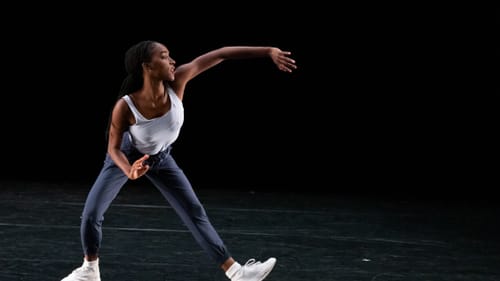Stay in the Loop
BSR publishes on a weekly schedule, with an email newsletter every Wednesday and Thursday morning. There’s no paywall, and subscribing is always free.
Ballet for the future
BalletX presents its 2022 Fall Series

The Fall Series from BalletX featured three diverse and entertaining dances, including world premieres by Darrell Grand Moultrie and Caili Quan along with the Philadelphia premiere of Become a Mountain by Justin Peck. Moultrie has worked with BalletX before, and Quan is a former dancer with the company. Meanwhile, Peck is the resident choreographer of the New York City Ballet. Peck also creates dance for film, perhaps most famously in Stephen Spielberg’s West Side Story (2021). BalletX aims to expand dance for a broad audience, and its commitment to staging new work consistently demonstrates remarkable artistic risk-taking. This can result in programs like grab bags, which was the case in the Fall Series. However, the company’s outstanding dancers always rise to the challenge of works that vary widely in style, tone, theme, and cohesion.
Love Letter
Inspired by Quan’s childhood in Guam, Love Letter celebrated its culture with movement, music, and themes of community and togetherness. Initially planned for BalletX’s 2020 Summer Series, the piece became a dance film before making its stage premiere here. A former BalletX dancer, Quan is now a choreographer with a knack for visually and emotionally appealing work.
A circle dance gave way to a pause as Shawn Cusseaux, Francesca Forcella, Savannah Green, Jared Kelly, Skyler Lubin, Jonathan Montepara, Demetrious Reed, Ben Schwarz, Ashley Simpson, and Andrea Yorita stood still while lit from offstage, seeming to stop to watch the sun rise or set. Michael Korsch’s lush lighting enhanced striking images throughout, including the opening scene, in which Forcella slowly walked downstage from a blue-lit backdrop as if emerging from the Pacific Ocean. Later, the lighting evoked the ocean, an effect heightened by the sounds of waves and the dancers’ swimming gestures. Kelly and Lubin danced a standout duet followed by Cusseaux’s mesmerizing shoulder and arm isolations before Forcella joined him.
Songs by Harry Belafonte set the tone for Love Letter’s most rousing sections. In the first, set to “Man Piaba” (1955), Cusseaux played a curious youngster who studies others to learn about relationships, sexuality, and himself. The second, “Jump in the Line” (1961), brought Love Letters to a conclusion as male dancers clapped their hands and female dancers nodded their heads and swung their skirts. But Quan and the performers conjured the touching final image, in which the dancers formed a tableau with their backs to the audience, holding hands and leaning on each other with the affection of a homecoming or reunion.
Sacred Impermanence
Moultrie’s Sacred Impermanence drew from the choreographer’s background in theater, ballet, modern, and commercial dance. The work included beautiful movement and masterful dancing set to classical and jazz music by Prokofiev, Clara and Robert Schumann, Dirk Maassen, and Bill Evans. Moultrie described the dance as honoring the importance of the present moment. This theme lacked development, though; the dance seemed to reflect an abstract exploration of time instead. Cusseaux served as the viewer’s guide through the piece, in which scenes arose and then passed.
Frequent variations in formation, tempo, and uses of the space contributed to this effect. For instance, in the opening scene, Cusseaux, Forcella, Green, Schwarz, and Yorita walked slowly around Simpson to a toccata piano solo. The dancers then formed two lines that moved laterally and switched positions. They filed out, leaving Cusseaux to perform an outstanding solo scored only by the syncopation of his breath.
A duet for Yorita and Cusseaux featured elegant lifts, spins, and balances punctuated by discordant motions, such as a chest bump and an awkward wrist gesture. Forcella’s gauzy gold skirt caught the light as she moved seamlessly from plié to relevé to sous sus. Sacred Impermanence concluded with all five dancers melting to the floor and lying on their backs, suggesting the permanence of death.

Become a Mountain
Become a Mountain was more abstract yet even more visually compelling. Performed by Cussaux, Forcella, Green, Kelly, Annika Kuo, Lubin, Montepara, Schwarz, Simpson, Yorita, and dance fellows Reed and Eli Alford, it was a highlight of the performance. The work takes its name from music composed by Dan Deacon, and Peck created it on the senior dance class at Juilliard in partnership with athletic shoe company On. Dancers wore sneakers and athletic wear, which illuminated dance’s locus at the intersection of athletics and art. It also provided a sartorial reminder of the restless energy students often feel before graduation.
Peck has spoken of his love of working with the corps de ballets, and this came across in Become a Mountain’s constant movement, shifting tempos, and evolving formations. In classical ballet, members of the corps often move as one and provide a backdrop for principal dancers (think of the snowflake waltz in The Nutcracker). Here, dancers moved both together and alone, suggesting the interplay between individual and collective identities as learners’ life paths converge and then disperse.
Several movement phrases and thematic gestures repeated to underscore Become a Mountain’s high energy. These included single-leg planks and energetic bursts, such as when dancers moved their arms frantically while planting their feet firmly. Hand gestures appeared aggressive when bright lights shone on the performers from the back and sides of the stage, then leveled off into grander and quieter power. Throughout, Become a Mountain conveyed a sense of encouraging support, as if reassuring those Juilliard students wondering about their post-graduation futures, “You got this.”
A backstage window
A short documentary by Elliot deBruyn shown after intermission provided an intimate inside look into the program’s three dances. The film included rehearsal footage and interviews with Quan and Moultrie as well as Jeanette Delgado, the artist who staged Become a Mountain for BalletX. The company has experimented with different documentary formats, as well as ways of incorporating them into live performances, and I appreciate a window behind the scenes. But I missed seeing dancers in pointe shoes, as Sacred Impermanence was the only piece in the program in which some dancers wore them. Yes, there is more to contemporary ballet than classical techniques, but a program performed largely in soft shoes, athletic shoes, and bare feet constituted a missed opportunity to connect ballet’s past, present, and future.
What, When, Where
BalletX 2022 Fall Series. Through December 4, 2022, at the Wilma Theater, 265 South Broad Street, Philadelphia. $25-70. (215) 545-7824 or balletx.org.
Accessibility
The Wilma currently requires patrons to stay masked during performances.
The Wilma is a wheelchair-accessible venue.
Sign up for our newsletter
All of the week's new articles, all in one place. Sign up for the free weekly BSR newsletters, and don't miss a conversation.

 Melissa Strong
Melissa Strong